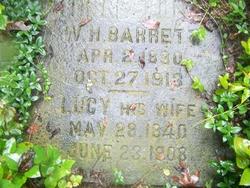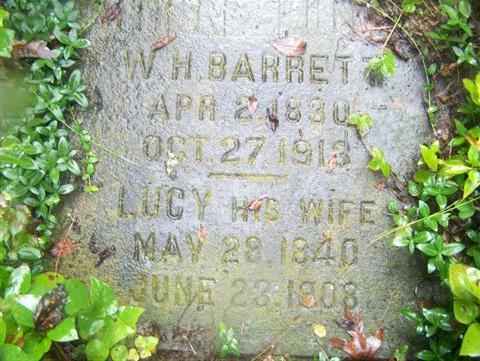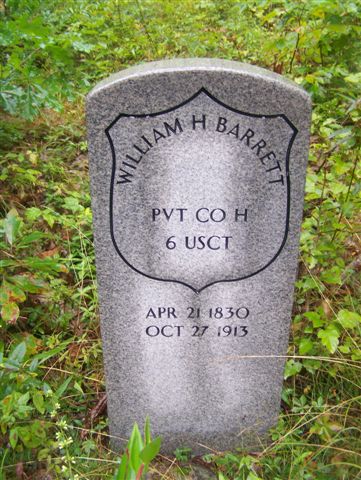Surgeons Certificates were given for debilitating disease, medical conditions, or wounds which were not necessiarily caused by combat wounds. However, military conditions, in those days were so abysmal that more soldiers died of disease then of combat deaths or wounds. Many men, discharged on a Surgeon's Certificate were unable to even walk, much less fight a battle and many succumbed to their conditions shortly after discharge while many lived the remainder of their lives with these disorders or wounds... This man served almost two years of honorable service and that was almost twice as much as the usual time served.
The United States Colored Troops (USCT) were regiments of the United States Army during the American Civil War that were composed of African-American soldiers. The men of the USCT were the forerunners of the famous Buffalo Soldiers.
SIXTH REGIMENT INFANTRY
USCT
Commanding Officer
Colonel John W. Ames
Leaving Camp William Penn on October 14th, 1863 the "6th" joined the army at Fortress Monroe, and was, in the course of its history, attached to the Eighteenth, Tenth and Twenty-fifth Corps. In its two years of service, the regiment had a more active part in a field of operations covering a large portion of two States than any other colored regiment originating in Pennsylvania. With its camp at Yorktown, Va., the regiment accompanied expeditions into North Carolina and to various points on the peninsula, joining the colored division under General B. F. Butler on the James River in May 1864, and participating in battles and operations incident to the siege of Petersburg and Richmond Its most notable record was gained at the battle of Chaffin's Farm (New Market Heights), where it lost most heavily. Here a company, led by Capt. John McMurray, went into the charge with thirty-two men and returned with but three. This was the greatest average company loss recorded of any troops in the course of the war. It was in this charge that Captain Robert B. Beath, subsequently commissioned Lieutenant-Colonel lost his leg.
With the Twenty-Fifth Corps in the operations of the North Carolina Coast at the beginning of 1865, the "6th" was in the advance upon and capture of Fort Fisher, and in the following campaign, which cleared eastern North Carolina of the enemy and finally lead to a junction with General Sheridan's army at Raleigh and the capitulation of Gen. Johnston, after which the "6th" performed garrison duty at Wilmington, N. C., to its muster out on September 20th, 1865. The chaplain, Rev. Jeremiah W. Asher, lost his life at Wilmington through attendance on men suffering from malignant fever.
TOTAL LOSSES.
Killed or mortally wounded officers... 8
Killed or mortally wounded men... 79
Died of disease officers... 5
Died of disease men... 132
Wounded and missing officers and men... 168
BATTLES and SERVICES
Expedition against Richmond
Skirmish near Williamsburg
Expedition - Yorktown to New Kent Court House
City Point
Petersburg (June 9th 1864)
Butler's operations against Petersburg and Richmond
Petersburg (assault June 15th 1864)
Petersburg (June 16th, 18th, 1864)
Dutch Gap
Chaffin's Farm (Fort Harrison)
Fort Fisher (December 1864)
Fort Fisher (January, 1865)
Sugar Loaf Battery, North Carolina
Occupation of Wilmington North Carolina
Skirmish Phillips Cross Roads, North Carolina
Surgeons Certificates were given for debilitating disease, medical conditions, or wounds which were not necessiarily caused by combat wounds. However, military conditions, in those days were so abysmal that more soldiers died of disease then of combat deaths or wounds. Many men, discharged on a Surgeon's Certificate were unable to even walk, much less fight a battle and many succumbed to their conditions shortly after discharge while many lived the remainder of their lives with these disorders or wounds... This man served almost two years of honorable service and that was almost twice as much as the usual time served.
The United States Colored Troops (USCT) were regiments of the United States Army during the American Civil War that were composed of African-American soldiers. The men of the USCT were the forerunners of the famous Buffalo Soldiers.
SIXTH REGIMENT INFANTRY
USCT
Commanding Officer
Colonel John W. Ames
Leaving Camp William Penn on October 14th, 1863 the "6th" joined the army at Fortress Monroe, and was, in the course of its history, attached to the Eighteenth, Tenth and Twenty-fifth Corps. In its two years of service, the regiment had a more active part in a field of operations covering a large portion of two States than any other colored regiment originating in Pennsylvania. With its camp at Yorktown, Va., the regiment accompanied expeditions into North Carolina and to various points on the peninsula, joining the colored division under General B. F. Butler on the James River in May 1864, and participating in battles and operations incident to the siege of Petersburg and Richmond Its most notable record was gained at the battle of Chaffin's Farm (New Market Heights), where it lost most heavily. Here a company, led by Capt. John McMurray, went into the charge with thirty-two men and returned with but three. This was the greatest average company loss recorded of any troops in the course of the war. It was in this charge that Captain Robert B. Beath, subsequently commissioned Lieutenant-Colonel lost his leg.
With the Twenty-Fifth Corps in the operations of the North Carolina Coast at the beginning of 1865, the "6th" was in the advance upon and capture of Fort Fisher, and in the following campaign, which cleared eastern North Carolina of the enemy and finally lead to a junction with General Sheridan's army at Raleigh and the capitulation of Gen. Johnston, after which the "6th" performed garrison duty at Wilmington, N. C., to its muster out on September 20th, 1865. The chaplain, Rev. Jeremiah W. Asher, lost his life at Wilmington through attendance on men suffering from malignant fever.
TOTAL LOSSES.
Killed or mortally wounded officers... 8
Killed or mortally wounded men... 79
Died of disease officers... 5
Died of disease men... 132
Wounded and missing officers and men... 168
BATTLES and SERVICES
Expedition against Richmond
Skirmish near Williamsburg
Expedition - Yorktown to New Kent Court House
City Point
Petersburg (June 9th 1864)
Butler's operations against Petersburg and Richmond
Petersburg (assault June 15th 1864)
Petersburg (June 16th, 18th, 1864)
Dutch Gap
Chaffin's Farm (Fort Harrison)
Fort Fisher (December 1864)
Fort Fisher (January, 1865)
Sugar Loaf Battery, North Carolina
Occupation of Wilmington North Carolina
Skirmish Phillips Cross Roads, North Carolina
Gravesite Details
Again, a discrepancy between the dates on the military marker and the family marker...Also, the two markers are not on the same grave...they are a small distance apart..
Family Members
Sponsored by Ancestry
Advertisement
Records on Ancestry
Advertisement













